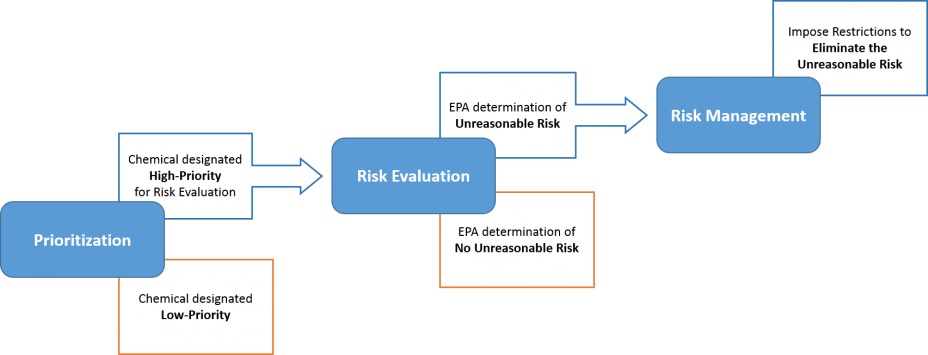How EPA Evaluates the Safety of Existing Chemicals
Overview
The Toxic Substances Control Act (TSCA), as amended by the Frank R. Lautenberg Chemical Safety for the 21st Century Act, requires EPA to evaluate the safety of existing chemicals via a three-stage process. The three stages of EPA’s process for ensuring the safety of existing chemicals are prioritization, risk evaluation, and risk management. The statute also includes a variety of new EPA authorities to drive forward progress on evaluating and ensuring the safety of existing chemicals. The following graphic provides an overview of the process for prioritization, risk evaluation and risk management of existing chemicals, including the key decisions to be made or actions taken at each step:
Once a chemical is in the process, which starts with proposed prioritization of a chemical, statutory deadlines are triggered for EPA to complete each stage of the process:
Prioritization
The first step in EPA’s process for evaluating the safety of existing chemicals is prioritization. Prioritization is a risk-based screening process for designating chemical substances as either High-Priority Substances for risk evaluation, or Low-Priority Substances for which risk evaluation is not warranted at the time. TSCA requires EPA to give certain preferences to prioritizing chemicals on the 2014 TSCA Work Plan, to consider certain criteria such as hazard/exposure, persistence and bioaccumulation, but otherwise does not significantly limit EPA's discretion to choose which chemicals enter the prioritization process. TSCA further prohibits EPA from considering non-risk factors (e.g., costs/benefits) during prioritization. Once initiated, the process provides stakeholders with ample notice of any EPA risk evaluation activity, as well as two opportunities for the public to submit relevant information to the Agency. The process has been designed to ensure that the Agency’s limited resources are focused on chemicals with the greatest potential for risk.
Chemical substances with low hazard and/or exposure that meet the definition of Low-Priority Substances are taken out of consideration for further assessment at this time. This gives the public notice of chemical substances for which the hazard and/or exposure potential is anticipated to be low or nonexistent, and provides insight into which chemical substances are likely not to need additional evaluation and risk management.
Learn more about EPA’s process for prioritizing existing chemicals for risk evaluation.
Risk Evaluation
The second step in EPA’s process for evaluating the safety of existing chemicals is risk evaluation. If EPA designates a chemical as a High-Priority Substance, the chemical moves immediately to the risk evaluation phase. At the conclusion of the risk evaluation phase, EPA must use the risk evaluation as a basis to determine whether or not the chemical presents an unreasonable risk to health or the environment under the chemical’s conditions of use. TSCA prohibits EPA from considering non-risk factors (e.g., costs/benefits) during risk evaluation. This includes risks to subpopulations who may be at greater risks than the general population, such as children and workers. The risk evaluation process has the following components:
- a scope document that provides the public with information on the focus of the risk evaluation;
- hazard and exposure assessments and a risk characterization to inform the risk determination; and
- a risk determination stating whether or not a chemical substance presents an unreasonable risk to health or the environment under its conditions of use.
In addition to EPA’s prioritization process, TSCA allows manufacturers to request that EPA conduct a risk evaluation on a particular chemical. When this happens, manufacturers are required to provide EPA with the information necessary to conduct a risk evaluation on those conditions of use that are of interest to them. Like the prioritization process, the risk evaluation process affords opportunities for public comment and submission of relevant information.
Learn more about EPA’s risk evaluation process for existing chemicals.
Risk Management
The third step in EPA’s existing chemicals process is risk management. If at the end of the risk evaluation process, EPA determines that a chemical presents an unreasonable risk to health or the environment, the chemical must immediately move to risk management action under TSCA. EPA is required to implement, via regulation, regulatory restrictions on the manufacture, processing, distribution, use or disposal of the chemical to eliminate the unreasonable risk. EPA is given a range of risk management options under TSCA, including labeling, recordkeeping or notice requirements, actions to reduce human exposure or environmental release, and a ban of the chemical or of certain uses. Like the prioritization and risk evaluation processes, there is an opportunity for public comment on any proposed risk management actions.

